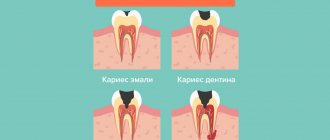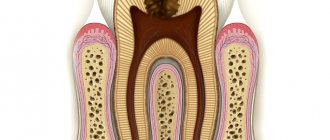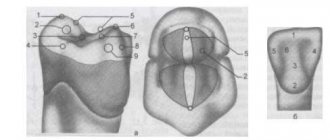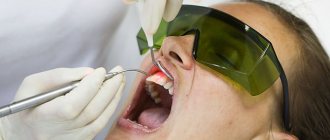Teeth are important organs that provide several human needs at once: an aesthetic effect and calmness of the nervous system, chewing food and the proper functioning of the digestive system, the formation of a bite, and therefore correct speech. At the same time, they are very delicate, and this is fraught with serious health problems for a person. If many often encounter painful caries, cysts in the gums, and destruction of the crown, then the situation when such a terrible disease as tooth cancer develops turns out to be very unexpected. If only because many people cannot even think about this type of oncology. The director of the dental studio Fedor Zakharov told AiF.ru about how tooth cancer can be hidden behind a harmless wound on the gum or a lump on the lip .
Question and answer Which brush is better: with natural bristles or synthetic?
What is the essence of the problem
The term “dental cancer” is used in everyday life, but it is not entirely correct. Yes, tumors can develop from tooth tissue: odontoma, cementoma, etc. But these are benign formations. Malignant is adamantinoma, which develops from tooth enamel, but is extremely rare and not fully understood. Most often the problem occurs in the lower jaw. Adamantinoma, in cases where it has been discovered, affects people at a fairly young age: 18-26 years. It is located in the area of the outer chewing teeth and in the corner of the mandibular bone. It can be of two types: dense and cystic. The first is a formation with a large number of cavities. The second is a formation filled with a brown mass.
The process resembles a cystic lesion of the cavity. As the tumor grows, the bone structures begin to thicken, which later combine into one bulge.
What can provoke such a terrible disease? These can be the most trivial reasons: chronic injuries to the mucous membrane, exposure to ionizing radiation, bad habits (smoking, chewing nasvay), occupational hazards (working in hot shops or dusty rooms), unhealthy diet (excessive consumption of spicy, pungent foods). In addition, there is a risk of developing jaw cancer in cancer patients with tumors of the kidneys, stomach, and lungs. In this case, they will talk about secondary oncology.
Drink milk and chew apples. How to eat for healthy teeth Read more
Treatment of dental granuloma –
Treatment for dental granuloma is usually only therapeutic. Treatment consists of mechanical treatment of the root canals, in most cases - temporary filling of the root canals with special medicinal pastes based on calcium hydroxide, after which after 2-3 weeks it will be possible to permanently fill the root canals with gutta-percha, as well as put a permanent filling. Below we will talk in more detail about how exactly this treatment is carried out.
Surgical treatment of tooth root granuloma may be required only in a few cases. For example, the operation of resection of the root apex may be indicated - 1) if the root canals are obstructed, 2) if it is impossible to unseal previously poorly filled root canals in order to treat the source of inflammation at the root apex, 3) if there is an artificial crown on the tooth, 4) if in A pin is installed in the root canal, an attempt to remove it may lead to a fracture of the tooth root.
Therapeutic treatment strategy –
- If the root canals have not been previously filled, it is necessary to drill out all carious tissues and old fillings, after which mechanical treatment of the root canals is carried out. After their expansion and antiseptic treatment, the strategy for further treatment may depend on the size of the granuloma.
If the tooth granuloma is small in size (up to 2-3 mm), then the root canal of such a tooth can, in principle, be filled immediately. If the size of the granuloma is from 3 to 5 mm, then a special therapeutic material based on calcium hydroxide is left in the root canals, which will allow the granuloma to shrink or even disappear completely.Temporary canal filling is carried out for a short period of time (on average 2-3 weeks). After this period, a control X-ray is taken, and if the granuloma has disappeared or decreased, the root canals are filled on a permanent basis, and a permanent filling is placed on the tooth. Algorithm for the therapeutic treatment of granulomas more than 3 mm in diameter, cystogranulomas and cysts (detailed descriptions appear when opening the photo) –
- If the root canals in this tooth are sealed (Fig. 7-11) - in this case, the root canals must first be unsealed, and then the treatment sequence corresponds to the previous option.
If such a tooth has an artificial crown, then usually they are first removed and the tooth is treated. And it must be said that in this case the crown will have to be made again. If you do not want to spend money on replacing the crown and filling the root canals, then in principle it is possible to do without it. A surgical root resection operation will help you with this, which means that through a small incision in the gum, the apex of the root with the unfilled part of the root canal and with a granuloma attached to the apex of the root will be cut off from the root.
Emergency care for purulent inflammation -
If you have a dental granuloma, then an exacerbation of the chronic process can lead to the development of purulent inflammation.
If the pus is localized inside the granuloma, then relief from acute pain is possible only after opening the tooth and unsealing the root canals, which will allow the pus to be released through them. How the outflow of pus occurs through the root canals - see video 1 below. But if there is significant swelling of the gums or cheeks, which indicates the release of pus under the periosteum or mucous membrane of the oral cavity, an incision will be required to release the pus. How to make a gum incision - see video 2.
Important: in some cases, a tooth with granulomas may need to be removed (for example, when the tooth crown is severely damaged and cannot be restored). In this case, it is very important that when removing a tooth, the dental surgeon must remove the granuloma from the tooth socket. We have already said above that in most cases they are tightly attached to the apex of the root, and therefore come out along with the tooth. However, in some cases, the granuloma remains in the socket, and then inflammation of the socket of the extracted tooth occurs (alveolitis).
What does a granuloma look like when scraped out of a socket after tooth extraction?
Treatment of dental granuloma with antibiotics -
It is impossible to treat dental granuloma with antibiotics. They can be prescribed only in case of exacerbation of the process (if purulent inflammation occurs) - in parallel with dental treatment carried out by the dentist. The fact is that it is impossible to sanitize infected root canals by simply taking antibiotics, which means the source of infection and inflammation will not disappear. By taking antibiotics, you can only achieve a temporary subsidence of the inflammatory process, but the granuloma itself will not even decrease in size. We hope that our article was useful to you!
Sources:
1. Dental education of the author of the article, 2. Based on personal experience as a dentist, 3. National Library of Medicine (USA), 4. “Therapeutic dentistry: Textbook” (Borovsky E.), 5. “Practical therapeutic dentistry” ( Nikolaev A.).
Dangerous symptoms
It is clear that diagnosing dental cancer is not so easy. It is worth being wary in cases where there is the appearance of long-term non-healing ulcers on the oral mucosa, deformations that are sometimes already noticeable to the eye, pain in untreated and intact teeth, when sensitivity changes. These are alarm bells that need to be responded to urgently and immediately run to the dentist. The earlier a tumor is detected, the greater the chance of minimizing losses.
It is also worth considering such an important sign as bleeding gums. If in a normal state, in order for blood to flow, you need to damage the gum, then in the case of cancer, light pressure will be enough. Also, swelling of the gums and increased body temperature may appear in parallel.
Recommendations after wisdom tooth removal
The main thing is to allow the gum to recover at its natural pace. Therefore, the doctor will give the following recommendations after the procedure and in case the extracted tooth aches too much:
- You should not eat for several hours.
- Subsequently, you should not allow food to get into the socket - you will need to chew on the other side of the jaw.
- Do not actively rinse your mouth and the extraction site.
- Do not touch the hole or try to clean it.
- You should not warm your jaw or drink hot drinks.
- The gum at the site of removal can be treated with an antiseptic.
These are general recommendations for recovery after tooth extraction, which can be supplemented with individual ones. Swelling will be accompanied by aching pain, so antibiotics are often prescribed for several days after the procedure.
There is no need to worry that there will be a bruise on your cheek after tooth extraction. This happens quite rarely and goes away along with swelling after a few days. An increase in body temperature is possible - therefore doctors recommend 1-2 days after the procedure to rest and recover. There may also be difficulty and pain when opening the mouth. This is also normal, everything will pass after a while.
Treatment
Tooth cancer requires surgery. And often, after tumor removal, reconstructive bone surgery may be required. Naturally, auxiliary types of therapy will also be determined if necessary: chemotherapy, radiotherapy, etc.
What happens to your teeth if you don't brush them? Infographics Read more
Problem statistics
Tooth cancer, like any other type of oncology, is dangerous due to its active development. And here the rule also applies: the earlier it is detected, the greater the chances of recovery. According to statistics, tooth cancer cured at stages 1-2 gives an 80% chance of five-year survival, at stage 3 the prognosis is 40%, at stage 4 - less than 15%. It is important to understand that the jaw is located close to the brain, and oncology is a metastatic disease. Therefore, you should not play Russian roulette; it is better to consult a doctor as soon as possible.
At the same time, no one has canceled prevention: even if nothing bothers you, you should visit the dentist once every six months. This will allow you to identify any pathologies at an early stage. After all, prevention is easier than cure.
Where can teeth come from in the ovary and legs from the brain?
Finding tumors with teeth, hair and even individual formed organs in the bodies of patients, surgeons of the distant past could easily accuse patients of witchcraft and collusion with the devil. Today it has long been known that such tumors - teratomas - arise due to impaired development of germ cells.
The disease is asymptomatic in 60% of cases. Problems begin only when teratomas increase in size so much that they begin to put pressure on surrounding organs. Pregnancy is considered one of the risk factors for their activation; they can also lead to complications during childbirth.
Ovarian teratomas are the most common; children also suffer from tumors - their teratomas usually form in the head area. In the vast majority of cases, teratomas are benign. However, despite being studied, their contents never cease to amaze.
My feet are in my brain
In 2008, in Colorado, doctors operated on a baby just three days old. A small tumor was discovered in his brain that needed to be removed. However, during the operation, surgeons were in for a surprise: in the child’s brain they found two feet, one of which was fully formed, the other partially formed, as well as a partially formed hand.
“Even the pathologist who opened the tumor was shocked,” they said
doctors to the press. “Perfectly formed body parts are a unique find.”
However, surgeons could not say with certainty whether the tumor was caused by a disorder of cell division or whether it was a parasitic twin that developed inside the host. In the early stages of a monozygotic twin pregnancy, when both fetuses share a placenta, one of them “wraps” itself around the other. The wrapped twin becomes a parasite and is dependent on the host twin for its continued survival. The parasitic twin is brainless and unable to survive on its own.
Surgeons from Saudi Arabia stumbled upon a similar “find” in 2000 -
in the stomach of a two-week-old boy they found
a hairy neoplasm in which they could identify two feet, two arms, a 15-centimeter intestine, brain tissue and even a penis with testicles.
Third Eye
Another tumor was discovered
in 1997 in Germany even before the birth of the child, during an ultrasound. Having identified a giant tumor in the sacral area, doctors came to the conclusion that it would be safer for the girl to have a caesarean section and surgery to remove the tumor than to wait until childbirth. The baby was born at just 29 weeks of development. The mass of the tumor was 4.5 kg, while the girl herself weighed only 950 g.
In the tumor tissues, surgeons found fragments of bone and cartilage tissue, striated and smooth muscles, blood vessels, and the intestinal lining.
But the most surprising discovery was a fully formed eye.
close
100%
Pediatric and Developmental Pathology, 1999
The tumor was diagnosed as a sacrococcygeal (sacrococcygeal) teratoma. Among newborns, the incidence of the disease is one case per 35 thousand children.
The girl was born alive. But during the operation to remove the tumor, she developed bradycardia and eventually the baby died from heart failure.
Another eye, although underdeveloped, was removed
in 2016 in Germany from the brain of a three-year-old boy. The family consulted a doctor with complaints of weakened muscles on one side of the child’s body, fatigue, and delayed speech development. MRI revealed a heterogeneous mass in the brain. Analysis of tissues after removal of the tumor showed that it contains the optic vesicle, the “embryo” of the eye, which is normally formed in the third week of embryonic development.
The tumor was completely removed, and after the operation the symptoms caused by its pressure on the brain disappeared.
Toothed ovaries
In 2015, in Brazil, a 25-year-old woman went to the doctor complaining of pain in her lower back, which had been tormenting her for two months. The initial examination did not reveal any pathologies, but an ultrasound of the pelvic organs showed
large, 10.3×9.2×8.6 cm, formation in the ovarian region.
After removal, doctors determined that it consisted mainly of fatty tissue, but the tumor also contained hair and teeth.
close
100%
Col?gio Brasileiro de Radiologia e Diagn?stico por Imagem
Teeth are not uncommon for ovarian teratomas, being found in more than a third of cases. From time to time they are even found in archaeological finds - for example, fragments of a neoplasm were found among the pelvic bones of a woman of the ancient Roman era in Spain. A small ball among the pelvic bones of an ancient Roman woman contained four teeth and a piece of bone.
.
“The outer walls of the tumor were calcified and preserved exceptionally well, given that these types of remains within the body structure are very, very fragile,” explained Assumpsio Malgosa, one of the study’s co-authors.
Another ovarian teratoma with teeth was discovered
in the remains of a woman who died in the 15th century in Portugal. The 45-year-old woman apparently died of illness and was buried in a cemetery in Lisbon. Archaeologists discovered her remains during excavations in 2010-2011. Having stumbled upon a small tumor, 4.3 cm in length, the researchers suggested that it could be an undeveloped fetus.
However, a more thorough analysis showed that the tumor contained five almost fully developed teeth - four molars and a canine.
close
100%
International Journal of Paleopathology (2017)
The woman does not appear to be suffering from a tumor, the researchers note. Judging by the fact that her skeleton was not deformed, the teratoma did not cause her any inconvenience.
Teratomas make up 24-36% of the total number of tumors in children and 2.7-7% in adults. Ovarian teratomas are one of the most common, they occur in a third of cases, as do teratomas that develop in the sacral area. 10-15% of tumors develop in the retroperitoneal space, 5-7% in the testicles, the same number in the rectum, about 5% in the chest cavity. Teratomas of the brain are the rarest.











